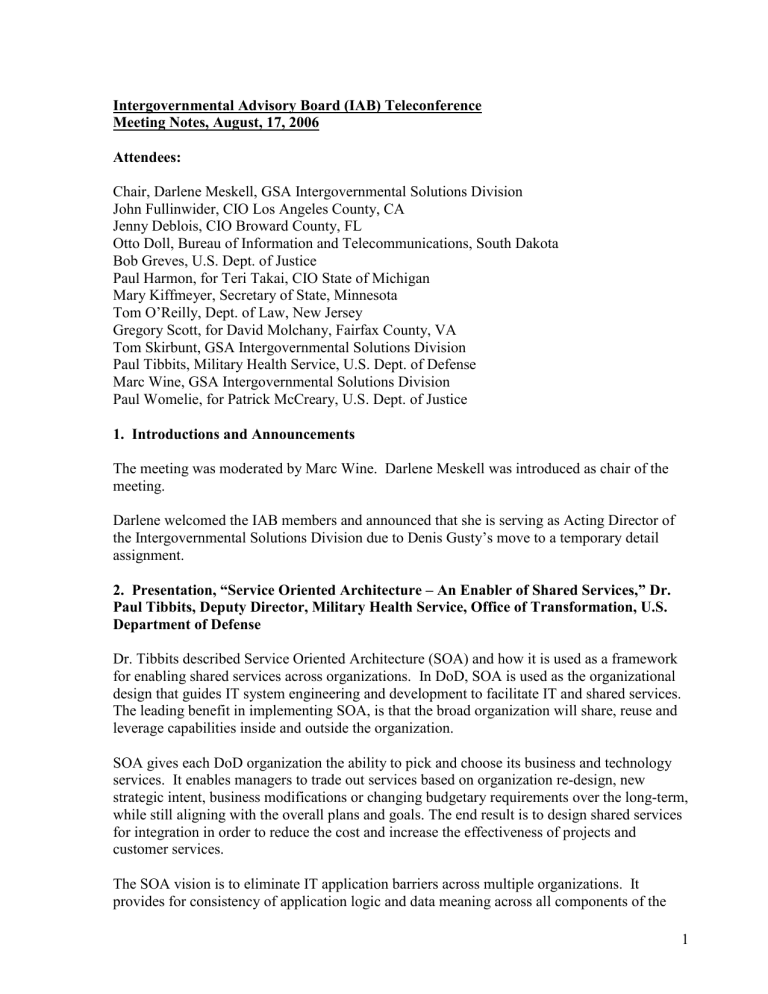Intergovernmental Advisory Board (IAB) Teleconference Meeting

Intergovernmental Advisory Board (IAB) Teleconference
Meeting Notes, August, 17, 2006
Attendees:
Chair, Darlene Meskell, GSA Intergovernmental Solutions Division
John Fullinwider, CIO Los Angeles County, CA
Jenny Deblois, CIO Broward County, FL
Otto Doll, Bureau of Information and Telecommunications, South Dakota
Bob Greves, U.S. Dept. of Justice
Paul Harmon, for Teri Takai, CIO State of Michigan
Mary Kiffmeyer, Secretary of State, Minnesota
Tom O’Reilly, Dept. of Law, New Jersey
Gregory Scott, for David Molchany, Fairfax County, VA
Tom Skirbunt, GSA Intergovernmental Solutions Division
Paul Tibbits, Military Health Service, U.S. Dept. of Defense
Marc Wine, GSA Intergovernmental Solutions Division
Paul Womelie, for Patrick McCreary, U.S. Dept. of Justice
1. Introductions and Announcements
The meeting was moderated by Marc Wine. Darlene Meskell was introduced as chair of the meeting.
Darlene welcomed the IAB members and announced that she is serving as Acting Director of the Intergovernmental Solutions Division due to Denis Gusty’s move to a temporary detail assignment.
2. Presentation, “Service Oriented Architecture – An Enabler of Shared Services,” Dr.
Paul Tibbits, Deputy Director, Military Health Service, Office of Transformation, U.S.
Department of Defense
Dr. Tibbits described Service Oriented Architecture (SOA) and how it is used as a framework for enabling shared services across organizations. In DoD, SOA is used as the organizational design that guides IT system engineering and development to facilitate IT and shared services.
The leading benefit in implementing SOA, is that the broad organization will share, reuse and leverage capabilities inside and outside the organization.
SOA gives each DoD organization the ability to pick and choose its business and technology services. It enables managers to trade out services based on organization re-design, new strategic intent, business modifications or changing budgetary requirements over the long-term, while still aligning with the overall plans and goals. The end result is to design shared services for integration in order to reduce the cost and increase the effectiveness of projects and customer services.
The SOA vision is to eliminate IT application barriers across multiple organizations. It provides for consistency of application logic and data meaning across all components of the
1
architecture. SOA constitutes an approach and opportunity to significantly improve the alignment of business operations and technology domains of an enterprise.
Dr. Tibbits highlighted several key features of SOA that contribute to enabling shared services to work in a complex organization:
Using service contracts – to specify all operational services and performance characteristics with underlying trust.
Establishing clear governance for authority and direction when trying to consolidate services and facilitate cross-service integration – to know exactly who is in charge of end-to-end processes and to focus on particular customer demands.
Using balanced score cards – to help enhance and measure performance through greater integration of operating units like electronic health records aligned to the overall enterprise plan.
Standardizing implementation – to make effective use of Web-based shared services across the enterprise
As shared services takes on new roles, new positions and new reporting relationships will need to be considered.
3. Discussion, “Shared Services – Issues and Examples from State and Local
Government – Otto Doll, Commissioner, Bureau of Information and
Telecommunications, South Dakota
As Commissioner of the South Dakota Bureau of Information and Telecommunications (BIT),
Otto Doll oversees development of all state government information systems and networks. His presentation outlined experiences and lessons learned implementing shared services in telecommunications across the state. The state’s geographic expanse makes developing shared services arrangements a matter of survival.
Key accomplishments of shared services planning in South Dakota:
Developed state portal, South Dakota Service Direct , containing all state forms —
1,319 forms and publications used by citizens and their businesses now online.
Established statewide 150 Mhz digital, trunked, radio system for all public safety organizations — over 10,000 radios centrally programmed and distributed to all local, state and federal agencies (highway patrol, game wardens, snow plows, etc.), county sheriffs, local police, fire fighters, emergency medical technicians, hospitals/clinics and transit bus drivers so that everyone can talk to anyone, anywhere in the state.
Established central repository of all state government GIS data assessable through the web — includes orthoquads, satellite imagery, etc. for entire state geography.
Built South Dakota Public Broadcasting (SDPB) into a nationally recognized public broadcasting leader — won over 50 awards in last five years.
Implemented Cisco academies throughout South Dakota’s K-12 high schools.
Wired all 660 public schools for telecommunications and power with inmate labor.
Connected all K-12 schools into wide area network with broadband connectivity — provides email and web hosting services to all administrators, teachers and students.
2
Established two-way, high quality videoconferencing network at every K-12 middle school and high school in the state — centralized scheduling for all 262 sites
(includes several state office sites).
Public agencies can benefit from lessons learned by the ways South Dakota leverages limited resources. Experience has shown technically that state and local government can better accomplish strategic goals through early adoption of emerging technologies.
For example, establishing all-broadband earlier than otherwise would have been possible is attributable to early implementation. Factors contributing to success include combining administrative people with front line service providers early in the decision making process. In addition, a clearly defined governance structure is important.
The shared services approach has encouraged a little more state IT spending than provided in the FY 2007 budget. Therefore, it is important to consider reducing staff up front. Creating a central IT organization encourages real transformation because performance enhancing, standardized software and hardware become readily available.
Anticipating culture change in plans for shared services is critical, as agencies need a long time to adjust to reductions of personnel. South Dakota experienced high turnover rates at the beginning of shared services implementation. In order to achieve success with shared services, changing organizational structures must be addressed early and repeatedly.
4. Wrap-up and Next Meeting
In conclusion, Dr. Tibbits suggested an idea to examine the need and lessons learned from federal, state and local agencies as means toward possible collaboration. Consideration might be given to identifying the top five service uses and related IT data areas in the U.S. like biosurveillance and pandemic disease threats for focusing the objectives of shared services.
Some possible topics to consider for the next IAB teleconference might be emergency preparedness, cyberinfrastructure and IPv6 Next Generation Internet. IAB members may submit their priority suggestions for the next topic.
The next IAB call tentatively will be scheduled for Thursday, November 16 th
.
3






